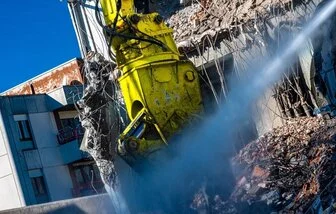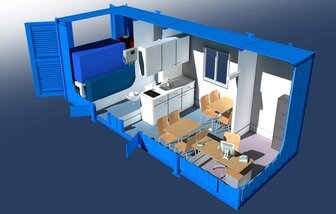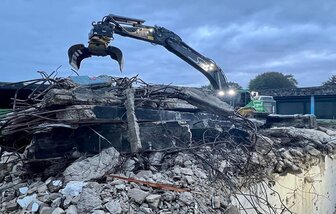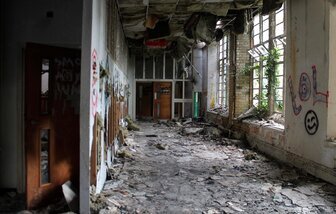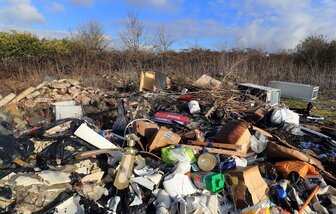Why is it Important to Terminate Utilities at the Boundary for Demolition?
Why do i need to terminate my utilities/ services before demolition? - Terminating utilities at the boundary is a critical step in the demolition process. It ensures the safety of the demolition crew and the surrounding environment, helps comply with regulations, prevents damage to utilities, streamlines the demolition process, minimizes environmental impacts, and prepares the site for future construction.
All you need to know about services disconnection before demolition
When it comes to demolishing a building or structure, there are several important considerations to take into account. One crucial aspect is the termination of utilities at the boundary.
This process involves disconnecting and shutting off all the necessary utility services before the demolition work begins. In this article, we will explore the reasons why terminating utilities at the boundary is essential for a successful demolition project.
Terminating utilities at the boundary is a critical step in the demolition process. It ensures the safety of the demolition crew and the surrounding environment, helps comply with regulations, prevents damage to utilities, streamlines the demolition process, minimises environmental impacts, and prepares the site for future construction.
By prioritising the termination of utilities, property owners and contractors can effectively and responsibly carry out demolition projects

1. Safety
The primary reason for terminating utilities at the boundary is safety. During the demolition process, there are inherent risks associated with live utility connections. By disconnecting and terminating the utilities, the risk of accidents, such as electrocution or gas leaks, is significantly reduced. This ensures the safety of both the demolition crew and the surrounding environment.
2. Compliance with Regulations
Another important reason to terminate utilities at the boundary is to comply with regulations and legal requirements. Most jurisdictions have specific guidelines and codes that dictate how utilities should be handled during demolition. By adhering to these regulations, property owners and contractors can avoid potential fines and legal complications.
3. Preventing Damage to Utilities
Demolition work involves heavy machinery, falling debris, and other activities that can potentially damage utility infrastructure. By terminating utilities at the boundary, the risk of accidental damage is minimized. This helps prevent costly repairs or disruptions to utility services in the surrounding area.
4. Efficient Demolition Process
Terminating utilities at the boundary allows for a more efficient demolition process. Without live utility connections, the demolition crew can work without any hindrances or delays. They can focus on the task at hand without having to worry about navigating around active utility lines or systems. This helps streamline the project timeline and ensures a smoother demolition process.
5. Environmental Considerations
Demolition projects have environmental implications, and terminating utilities at the boundary plays a role in minimizing these impacts. By shutting off utilities, the potential for environmental contamination is reduced. For example, by disconnecting water and sewer lines, the risk of pollutants entering the surrounding soil or water sources is mitigated.
6. Preparation for New Construction
Terminating utilities at the boundary also sets the stage for future construction or redevelopment. By disconnecting existing utility connections, it becomes easier to plan and implement new utility systems for the upcoming project. This ensures a clean slate for the construction team and allows for more efficient installation of new utilities.
Introduction
When preparing for a demolition project in the UK, it is crucial to ensure that all necessary services are terminated properly. This includes disconnecting utilities, such as gas, water, and electricity, to ensure a safe and efficient demolition process. In this article, we will guide you through the steps to get your services terminated and ready for demolition.
1. Notify Service Providers
Before commencing the demolition process, it is important to inform your service providers about your plans. This will allow them to schedule the termination of services and avoid any unnecessary disruptions. Contact your gas, water, and electricity providers well in advance and provide them with the relevant details of your demolition project.
2. Gas Service Termination
To terminate your gas service, you will need to contact your gas provider and request a disconnection. They will guide you through the process and may require specific information, such as the date of demolition and the address of the property. It is important to note that only a Gas Safe registered engineer should carry out the disconnection to ensure safety standards are met.
3. Water Service Termination
For terminating your water service, you will need to contact your water supplier. They will provide you with the necessary instructions and paperwork to complete the process. This may include filling out a termination form and providing details about the demolition project. It is advisable to schedule the termination well in advance to avoid any delays.
4. Electricity Service Termination
To terminate your electricity service, you will need to contact your electricity provider. They will guide you through the process and may require specific information, such as the date of demolition and the meter reading. It is important to arrange for a qualified electrician to disconnect the electricity supply safely and in compliance with regulations.
5. Telecom and Internet Services
In addition to gas, water, and electricity, you should also consider terminating any telecom and internet services. Contact your service providers and inform them about the demolition project. They will guide you through the process of terminating your services, which may involve returning equipment or cancelling contracts. It is important to give sufficient notice to avoid any penalties or additional charges.
6. Secure Documentation
Throughout the process of terminating services, it is essential to keep a record of all correspondence, including emails, letters, and termination forms. These documents will serve as proof of your requests and will be valuable in case of any disputes or issues that may arise in the future.
7. Safety Considerations
While terminating services, it is crucial to prioritize safety. Engage professionals who are qualified and experienced in handling the termination process for each service. This will ensure that all necessary safety measures are followed, minimizing any potential risks during the demolition process.
Conclusion
Getting your services terminated and ready for demolition in the UK requires careful planning and coordination with your service providers. By following the steps outlined in this article, you can ensure a smooth and efficient termination process, allowing for a safe and successful demolition project.
Demolishing a property can be a complex process, requiring careful planning and coordination. One important aspect to consider is the reconnection of utilities and services once the demolition is complete. Whether you are rebuilding on the same site or preparing the land for a new project, it is essential to know how to get your utilities and services reconnected. In this article, we will discuss the steps you need to take and who to contact for this process.
1. Understand the Demolition Process
Before you can proceed with reconnecting utilities and services, it is crucial to understand the demolition process. Demolition involves tearing down and removing existing structures, which may include residential or commercial buildings. It is essential to work with a professional demolition company that is familiar with local regulations and can guide you through the process.
2. Notify Utility Companies
Once the demolition is complete, you need to notify the utility companies about your intention to reconnect services. This includes electricity, water, gas, sewage, and any other services that were previously connected to the property. Contact each utility company individually to inform them about the demolition and your plans for reconnection.
3. Provide Necessary Information
When contacting the utility companies, be prepared to provide them with specific information. This may include the address of the property, the date of demolition completion, and any other relevant details they may require. It is essential to have all the necessary paperwork and documentation ready to ensure a smooth reconnection process.
4. Schedule Inspections
Depending on local regulations and the extent of the demolition, you may need to schedule inspections before utilities can be reconnected. These inspections are typically conducted to ensure that the property meets safety standards and is ready for service reconnection. Contact your local building department or relevant authorities to determine if any inspections are required.
5. Hire Licensed Professionals
In some cases, you may need to hire licensed professionals to handle specific aspects of utility reconnection. For example, if you are reconnecting gas or electrical services, it is crucial to work with certified technicians who can safely handle these installations. Hiring licensed professionals will ensure that the reconnection is done correctly and in compliance with regulations.
6. Budget for Reconnection Costs
Reconnecting utilities and services after demolition may come with associated costs. It is important to budget for these expenses and factor them into your overall project costs. The reconnection costs will vary depending on the location, the type of services, and any additional requirements or upgrades that may be necessary.
7. Coordinate with Contractors
If you are rebuilding on the same site after demolition, it is crucial to coordinate with your contractors. Ensure that they are aware of the reconnection timeline and any specific requirements related to utilities and services. Effective communication and coordination will help streamline the process and avoid any delays or complications.
8. Patience is Key
Reconnecting utilities and services after demolition may take time, so it is important to be patient. The process involves multiple parties and coordination efforts, and unforeseen circumstances can sometimes cause delays. Stay in touch with the utility companies and follow up regularly to ensure that the reconnection is progressing as planned.
Conclusion
Reconnecting utilities and services after demolition is a crucial step in any rebuilding or redevelopment project.
By understanding the demolition process, notifying utility companies, providing necessary information, scheduling inspections, hiring licensed professionals, budgeting for reconnection costs, coordinating with contractors, and being patient, you can ensure a smooth and successful reconnection process. Remember to consult with local authorities and professionals to ensure compliance with regulations and to obtain any necessary permits. With careful planning and coordination, you can have your utilities and services reconnected efficiently after demolition.
What is demolition?
The process involves Rotational hydraulic shears and rock-beakers attached to specialist excavators are also used to cut or break through wood, cut steel and crush concrete which reduces the structure to a rubble
Securing your demolition project
Implementing robust security measures, such as perimeter fencing, access control, signage, surveillance systems, and proper lighting, can significantly reduce the
Demolition hazards
If a demolition project is well planned the risks of injury and death can be minimised. It should be emphasised that the planning and execution of a demolition project should only be done by appropriately competent persons.
Notification of intended demolition Section 80
If your considering demolishing an existing building you will need to submit a demolition, Section 80 Notice together with your (RAMS) to your local authority according to section 80
Welfare facilities
Welfare facilities are an essential component of any demolition project. By providing suitable facilities, employers prioritize the well-being and safety of their workers, leading to increased
Demolition plant
Demolition plant is essential in the construction industry, as they ensure the safe and efficient removal of structures. By following strict guidelines and regulations, these plants prioritise safety, efficiency, and sustainability.
Utilities disconnection
Terminating utilities at the boundary is a critical step in the demolition process. It ensures the safety of the demolition crew and the surrounding environment, helps comply with regulations, prevents damage to utilities
Internal soft strip
Soft strip demolition is a crucial process that involves the removal of the internal structure of a building, making it ready for demolition or refurbishment. This process includes the careful removal of various materials.
Planning your demolition project
Learn how to create an effective demolition plan for your construction project. This comprehensive guide covers the key steps, including site assessment, hazard identification, safety measures, waste management, and more.
Managing asbestos
Learn about the dangers of asbestos, its different types, and where it can be found. Understand the health risks associated with asbestos exposure and the importance of proper testing and safe removal. Protect yourself and others from the harmful effects of asbestos.
Dealing with waste
Learn about waste management practices in demolition projects and the legal requirements that must be followed. Understand the types of demolition waste, effective waste management practices, and the laws and regulations governing waste management
Hazardous waste liquids
Hazardous liquids in demolition projects. Understand the importance of identifying, segregating, and properly disposing of hazardous waste. Follow the guidelines the safe handling, storage, and disposal of hazardous
Ready to start your project ?
Let's Work Together
Please complete the form below and someone from the Total team will be in touch.

